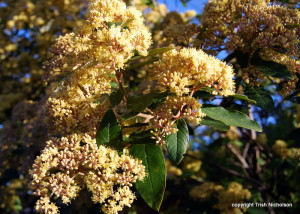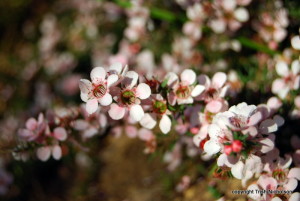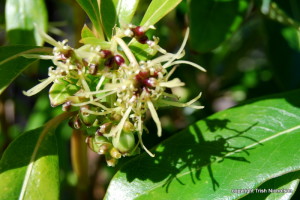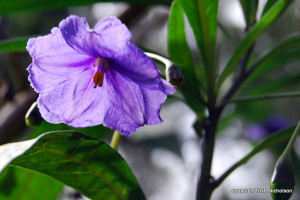 September first is officially spring in New Zealand, but what that means outside the window depends on where you live. Up here in the Far North, just within the subtropics, already evenings are lighter and the days warmer. Nothing can be taken for granted, though, weather changes here by the hour, and as I write, cold and wet prevail, so it seemed a good idea to dwell on the flowery side of spring – to share with you a few of our native blossoms.
September first is officially spring in New Zealand, but what that means outside the window depends on where you live. Up here in the Far North, just within the subtropics, already evenings are lighter and the days warmer. Nothing can be taken for granted, though, weather changes here by the hour, and as I write, cold and wet prevail, so it seemed a good idea to dwell on the flowery side of spring – to share with you a few of our native blossoms.

First to smile on us is always the kumarahou, (Pomaderris kumeraho) with all its feathery creaminess. Different subspecies grow as small trees, shrubs, or ground cover bushes. In Maori medicine, a decoction of leaves is applied as a skin tonic and drunk as a bitter tea to relieve respiratory conditions and cleanse the blood. The frothing qualities of the flowers made them a useful cleanser; early settlers calling it ‘gum-diggers soap’.
 Manuka (Leptospermum scoparium), commonly known as tea tree and found all over New Zealand, is probably our best known tree. Manuka provides shade, firewood, protective cover for other young trees and survives in the harshest conditions, wet or dry, and the bees love it. Its generosity extends to many medicinal uses; I extract the oil from its leaves to make healing skin balm.
Manuka (Leptospermum scoparium), commonly known as tea tree and found all over New Zealand, is probably our best known tree. Manuka provides shade, firewood, protective cover for other young trees and survives in the harshest conditions, wet or dry, and the bees love it. Its generosity extends to many medicinal uses; I extract the oil from its leaves to make healing skin balm.
 What’s in a name? The poor Coprosma has been landed with an unfortunate label, from the Greek kapros (dung) and osme (odour), but it grows in many forms from ground huggers to 10 metre trees, all prolific in their supply of berries for the birds. Pictured is C. grandiflora bearing several Maori names: kanono, manono and ruarekau. These are female flowers; some subspecies produce male flowers as well – LGBT is not a problem for New Zealand native plants.
What’s in a name? The poor Coprosma has been landed with an unfortunate label, from the Greek kapros (dung) and osme (odour), but it grows in many forms from ground huggers to 10 metre trees, all prolific in their supply of berries for the birds. Pictured is C. grandiflora bearing several Maori names: kanono, manono and ruarekau. These are female flowers; some subspecies produce male flowers as well – LGBT is not a problem for New Zealand native plants.
 Although many of our flowers are tiny and white, they reward a close look to appreciate their exquisite details. But one of the more colourful is the violet bloom of the poroporo (Solanum laciniatum), related to the potato and the aubergine. The berries, though poisonous when green, are edible when ripened to yellow and bright orange, their astringent taste a traditional favourite of Maori children, and enjoyed by settlers in jams and pies.
Although many of our flowers are tiny and white, they reward a close look to appreciate their exquisite details. But one of the more colourful is the violet bloom of the poroporo (Solanum laciniatum), related to the potato and the aubergine. The berries, though poisonous when green, are edible when ripened to yellow and bright orange, their astringent taste a traditional favourite of Maori children, and enjoyed by settlers in jams and pies.

Another small, white flower, but what a combination with the purple-backed leaves of lacebark (Hoheria populnea), a small tree growing to about 6 metres and one of five sub species which are all endemic to New Zealand, i.e. occurring nowhere else. In the old days, the pulped bark was popular as a poultice for boils and wounds; the lacy inner bark worked to make rope, baskets, slings, and swaddling for young babies.
And finally, the glorious kowhai (Sophora microphylla) main herald of spring; too impatient to wait for all its new leaves to appear it is sometimes in full bloom on almost bare stems. Kowhai has many uses in traditional Maori medicine, from bark used as a poultice on skin sores, to purgative infusions. And seeing its drama, perhaps it is not surprising that kowhai featured in sorcery to deflect enemy spears. Spring has, after all, magic and optimism all its own.

[If you are interested in traditional Maori medicine you can learn more about it from: Maori Healing and Herbal, Murdoch Riley, Viking Sevenseas N.Z.]
If you have a special interest in nature, alternative medicine, magic, culture or history for example, why not share your enthusiasm and knowledge by writing a book? I offer you guidance, tips and techniques from forming your initial idea, right through the whole process to publishing and marketing your book in, Writing Your Nonfiction Book – The Complete Guide to Becoming an Author
